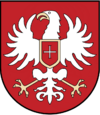User:Luziyca/Sandbox
| Part of a series on |
| Life in West Miersa |
|---|
 |
Demographics in West Miersa are gathered by a decennial census held every ten years by the Ministry of Social Development, with the census collecting data on information relating to population and its distribution by age, ethnicity, religion, language, and whether they live in urban areas or not, among other data.
(TBC)
Population
As of the 2017 census, there are 17,906,711 people residing in the territories controlled by the Miersan Federation (i.e. excluding the eastern voivodeships and the separatist-controlled regions of Małomiersa). This is a decrease of X since the 2007 census.
(TBC)
Age distribution
Ethnicity
Of the 17,906,711 people residing in the Miersan Federation, the largest ethnic group are the Miersans, comprising 68.7% of the population, or 12,298,192 people, and spread out across West Miersa. The next largest ethnicity are the Narodyns, comprising 18.7% of the population, or 3,349,476 people, and predominantly concentrated near the border with Narozalica, Vedmed, and Velzemia, and also in major cities like Krada, Sechia, and West Żobrodź.
Of the remaining 12.6% of the population, major minority groups among the remainder of the population include the Vedmedis, forming approximately 1.8% of the population, or 314,770 people, Lemovicians, forming 1.1% of the population, or 199,061 people, Savaders, forming 0.8% of the population, or 149,345 people, and (TBD). A wide array of ethnic groups form the remainder of the population, including Zalyks and Witterites.
Religion
The largest religion in the Miersan Federation is Episemialist Sotirianity, comprising approximately 85.0% of the population, or 15,228,956 people. Virtually all Episemialists in West Miersa are members of the Miersan Episemialist Church, with only a handful of recent Episemialist immigrants not being members of the Miersan Episemialist Church. The next largest religion in the country is the Solarian Catholic Church, followed by 12.1% of the population, or 2,168,236 people.
Finally, of the remaining 2.9% of the population, or 509,519 people, 254,767 people, or 1.4% of the population, are irreligious, while the remainder follow other religions, with the largest minority religions or sects being Witterism, Marolevic neopaganism, and TBD.
Per the West Miersan constitution, Sotirianity is the state religion, although the document specifies that "all sects of Sotirianity shall be considered official, in order to accommodate both those who follow the Episemialist and the Catholic Churches," in addition to allowing practice of beliefs other than Sotiranity.
Language
Under the West Miersan constitution, the Miersan Federation only recognises Miersan as the official language. However, per the first amendment in 1957, the government has permitted the granting of minority language status, although since 1961, only Narodyn has been designated a minority language.
As of the 2017 census, around 66.9% of the population, or 11,979,590 people, declared Miersan to be their first language. This is followed by Narodyn, spoken by around 23.5% of the population, or 4,208,077 people, as a first language. Finally, 9.6% of the population, or 1,719,044 people have declared other languages, primarily Vedmedi, Lemovician, or Savader, to be their first language.
While the census does not report on dialect usage, there are three major dialects of Miersan spoken across the country, including northwestern dialect spoken in northern West Miersa, the central dialect, spoken in the central regions of the country, which is the standard language, and the southwestern dialect, spoken in the southern regions of the country. In addition, surzhyk is prevalent, particularly in the western regions near the border with ex-Narozalic countries, although one of the most infamous examples of surzhyk, the Kradian dialect, is close to extinction as of 2020.
Largest cities
| Rank | Voivodeship | Pop. | Rank | Voivodeship | Pop. | ||||
|---|---|---|---|---|---|---|---|---|---|
 Krada  Sechia |
1 | Krada | Swiecizar | 891,411 | 11 | Dlugopol | Starykrol | 63,672 |  Podgorzyca  Gorgard |
| 2 | Sechia | Malomiersa | 297,137 | 12 | Most Bytnara | Swiecizar | 59,427 | ||
| 3 | Podgorzyca | Starykrol | 222,843 | 13 | Bonczek | West Zobrodz | 55,713 | ||
| 4 | Gorgard | Wyzyny | 178,281 | 14 | Bystok | Starykrol | 52,436 | ||
| 5 | Zanica | Czekanie | 127,344 | 15 | Domwiej | Malomiersa | 46,916 | ||
| 6 | Rycerow | Zanawiwasie | 111,426 | 16 | Zamek Strazniczy | Krowielie | 44,571 | ||
| 7 | Tarclaw | Swieciżar | 99,046 | 17 | Debowo Lesne | Swiecizar | 42,448 | ||
| 8 | Damsyl | Krowielie | 89,146 | 18 | Mostar | Malomiersa | 40,519 | ||
| 9 | Zierun | Jelenawie | 81,037 | ||||||
| 10 | Wisniow | West Zobrodz | 68,571 | ||||||
As of the 2017 census, (TBC).